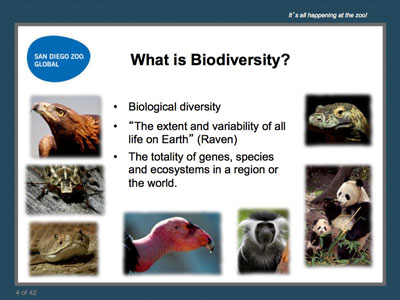 |
Time Management: Information Overload |
1.00 |
This course will focus on how to identify the causes of information overload and overcome it by screening information, control paperwork by organizing your office and filing system, and communicate effectively to increase productivity. |
 |
Tigers |
2.00 |
This course will provide an introduction to tigers, including an overview of physical characteristics, habitat, behavior, reproduction and the conservation efforts dedicated to protecting this species.
|
 |
The Value of Biodiversity and its Link to Human Welfare |
1.00 |
Participants will explore the question: "What is the value of biodiversity?" We'll discuss biodiversity's value from intrinsic and utilitarian perspectives and discuss why saving Earth's species is a critically important matter for all humans. The personal link between biodiversity and human wellbeing has been demonstrated in numerous studies, a compelling body of research that we'll discuss here. Lastly we'll discuss the current plight of global biodiversity and how we can each personally help to alleviate threats. |
 |
The Value of a Great Strategic Plan |
2.00 |
During this course, you'll see how a great strategic plan can help you achieve a deep understanding of your purpose, clarify your priorities, and deliver maximum mission impact - without sacrificing financial sustainability. At the end of the course, we will show how strategic planning at San Diego Zoo Global helped to transform our organization, generated impressive results, and paved the way for a better future for wildlife. |
 |
The Six Ps of Marketing School-Age Programs |
2.00 |
Effective marketing of school-age programs is a systematic process that involves research, analysis, assessment of market trends and needs, short-term and long-term planning, and development of effective strategies to promote school-age program services and develop a positive image of the program in the community. It is important for school-age care leaders to recognize that marketing is a far reaching process that includes, but is not limited to, advertising and publicity. When leaders take a comprehensive approach to marketing, their programs and projects have an excellent chance of success. Knowledge and understanding of the marketing process is an invaluable tool for leaders as they plan and implement new programs and projects, assess the stability and need for improvement of current programs, develop plans for new or expanded programs, and develop a positive public image of the program and its services. |
 |
The Science Supporting Breeding and Transfer Plans |
2.50 |
This course is intended to provide participants with a broad understanding of why and how animal breeding and transfer recommendations are made for cooperative breeding programs. This course is appropriate for animal care staff involved in management and collection planning at zoos and aquariums. |
 |
The Safe Food Handler |
0.50 |
This course covers how food workers introduce germs, bacteria, and viruses into the workplace. Furthermore, this course covers methods for abating foodborne illnesses in the workplace and keeping the transmission of foodborne illnesses low. This information is based on the Food and Drug Administration's 2022 Food Code. |
 |
The Role of the Site Leader |
2.00 |
Supervising adults is challenging under any circumstances, but in out-of-school time, supervision can be even more challenging because those supervised needs to be independent workers who are creative, energetic, enthusiastic and calculated risk takers. The afterschool site leader must have an arsenal of skills and strategies to be both a leader and a supervisor. This course offers a basic overview of the roles and responsibilities of the site leader or supervisor and how those roles support a culture of team excellence and mutual support. |
 |
The Role of Staff in Behavior Guidance: Middle and High School Students |
2.00 |
Guiding and managing the behavior of youth are some of the biggest challenges that out-of-school time program staff face.
By the end of this course, you will be able to:
- Understand your reactions to the behaviors of children and youth, and learn to use this information to respond more effectively.
- Learn to use behavior guidance strategies at the appropriate time. |
 |
The Role of Staff in Behavior Guidance: Elementary Students |
2.00 |
Guiding and managing the behavior of children and youth are some of the biggest challenges that out-of-school time program staff face. Staff needs to be actively engaged in supporting children and youth in:
1. Building inner self-control.
2. Making and fostering friendships with children and youth from all backgrounds.
3. Making responsible, age-appropriate choices.
4. Understanding natural and logical consequences for behaviors.
5. Taking responsibility for behaviors.
By the end of this course, you will be able to:
- Understand your reactions to the behaviors of children and youth, and learn to use this information to respond more effectively.
- Learn to use behavior guidance strategies at the appropriate time. |











